17 Essential Yoga Poses for Intermediate and Advanced Practitioners
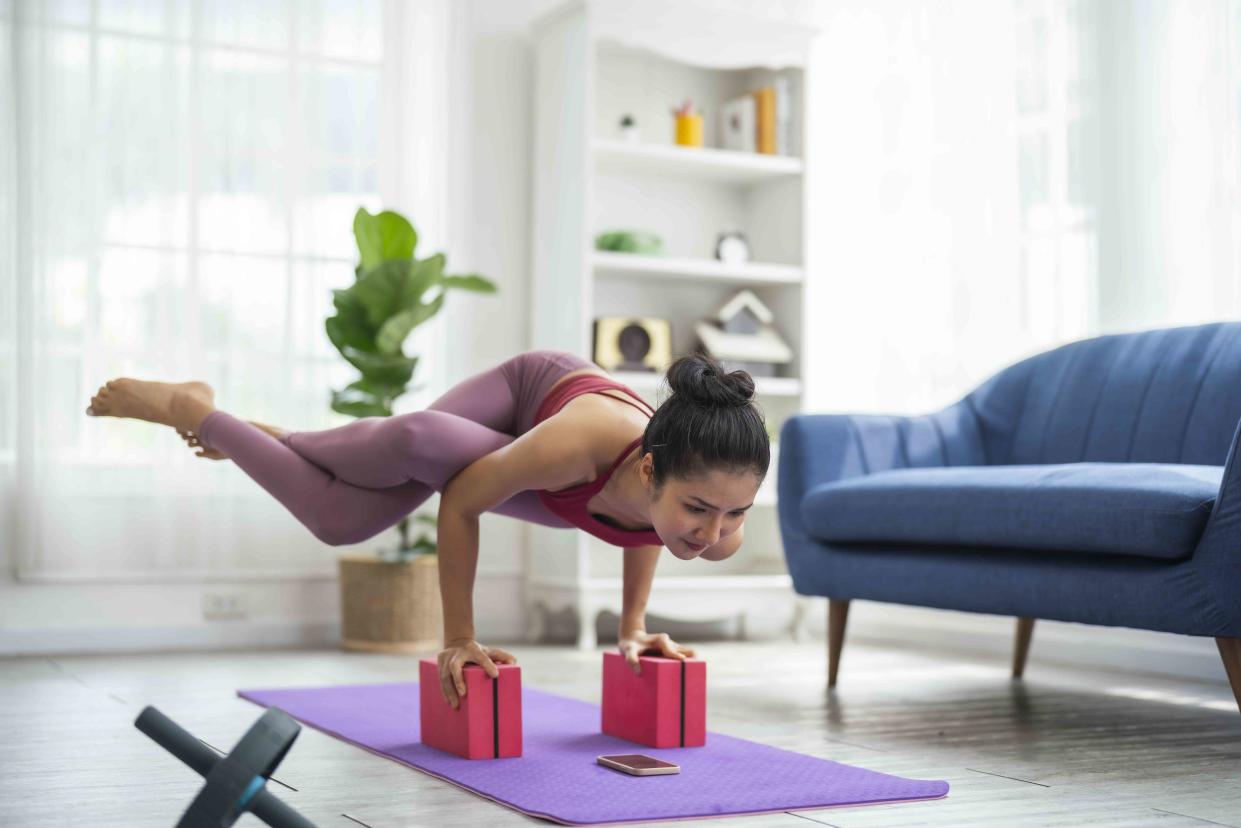
Getty Images / Witthaya Prasongsin
Medically reviewed by Kristin McGee, CPT
As you make your way through your yoga course, you might be surprised by how well you’re able to grasp the seemingly endless wealth of knowledge that makes up this ancient holistic practice. Yoga can be quite intricate and involve more poses than you could have ever anticipated. Becoming an intermediate or advanced practitioner involves a great deal of work—spiritually, mentally, and, of course, physically.
It can take a while before you feel truly familiar with all of the postures as well as the breathing techniques involved. “Someone who is very dedicated and practices 4-5 times a week can become intermediate or advanced faster; but, to be honest, I've been practicing now 30 years, and I still have a beginner's mindset,” explains Kristin McGee, celebrity yoga and Pilates teacher who helped launch Peloton’s interactive classes. I love to stay open to learning and practice and to keep evolving constantly.
As an intermediate or advanced practitioner, you will take on significantly more challenging poses, from arm balances and inversions to handstands and backbends. These poses, as difficult as they may be to adopt, help push us out of our comfort zone and teach us how to be very mindful of how we move, explains McGee. “If we don't open up enough, use our breath, and strengthen our joints and muscles, we won't be able to hold these more advanced positions,” she says. “Not all postures are for everyone, and being a really advanced yogi is learning when to honor yourself and not push yourself past your limitations.”
No matter your level of experience in your practice, maintaining proper form and alignment is key and will help guide you along your journey. Ensuring that your weight is evenly distributed will prevent your muscles from overbearing weight and cut down on your risk of injury, notes Jamie Bacharach, Dipl. AC, a diplomate of acupuncture with Acupuncture Jerusalem. “Additionally, proper alignment means that the muscles being targeted in certain poses are being adequately strengthened and engaged, which helps ensure that all your muscles are being properly trained and there are no inconsistencies.”
Essential Yoga Poses for Intermediate/Advanced Yogis
To help guide you in your practice, here are 20 different yoga poses that are ideal for intermediate or advanced practitioners.
Crow Pose
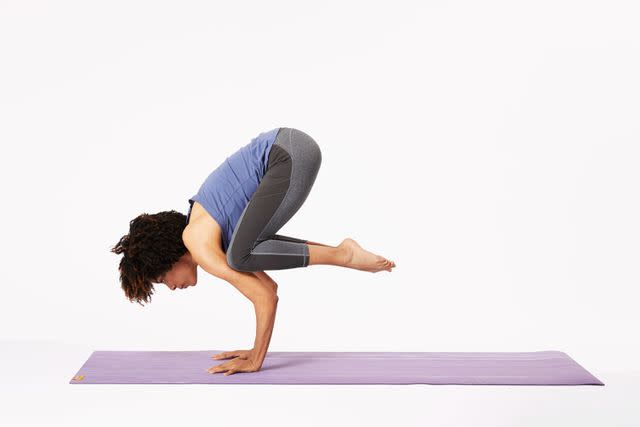
Verywell / Ben Goldstein
Pose type: Balancing
Also known as Crane Pose or Frog Stand, this intermediate yoga pose requires you to balance on your hands with your knees in your armpits or around your upper arms and your feet hovering off the floor.
“It's great for hip opening, upper body strength, and core strength,” notes McGee. In order to make this pose work for you, she recommends making sure that your knees are high enough on your arms to allow you to balance properly. The ideal distribution of weight is what will allow you to balance effectively and make this pose work for you.
Wheel Pose
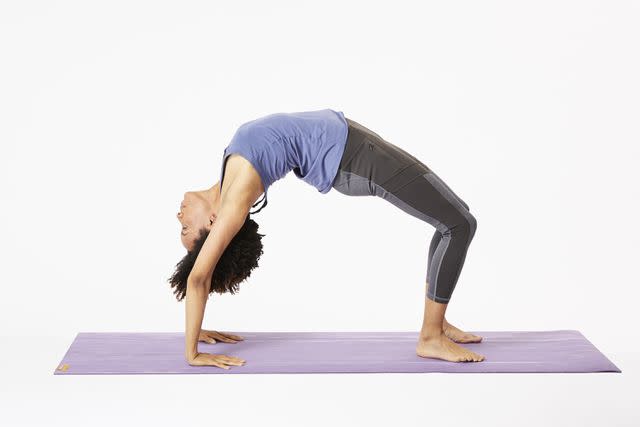
Verywell / Ben Goldstein
Pose type: Backbend
Wheel pose, or Urdhva Dhanurasana, helps encourage spinal mobility and opens up your chest to strengthen your shoulders, arms, and legs.
McGee recommends starting in a lying-down position with your hands by your ears and your fingers facing your shoulders. Press your body up, creating a wheel shape.
“It's a super deep shoulder opener and requires a lot of strength in an extension and a great way to open up the front body and strengthen the back body,” she says.
Headstand
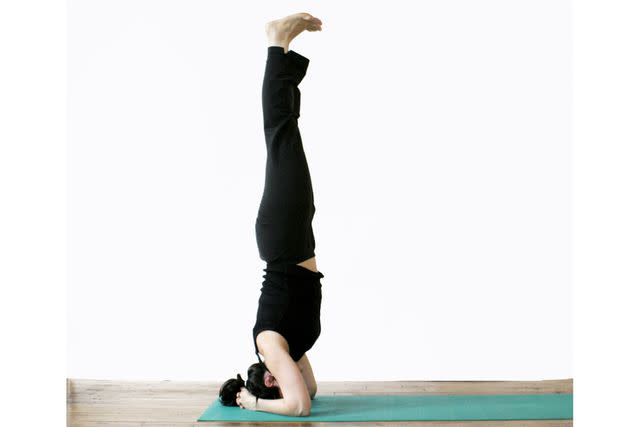
Pose type: Balance
Also known as Sirsasana, this advanced pose targets your core and brings blood flow to the brain. It also requires a great deal of shoulder strength and helps you improve your overall balance.
“With your hands interlaced and your forearms on the floor, place the crown of your head between your hands, walk your feet in as close as you can to create an egg shape, lift your legs up on the floor and straight up to the ceiling,” says McGee. “Be very mindful the upper body is supporting you, not all of the weight is on your head.”
Handstand
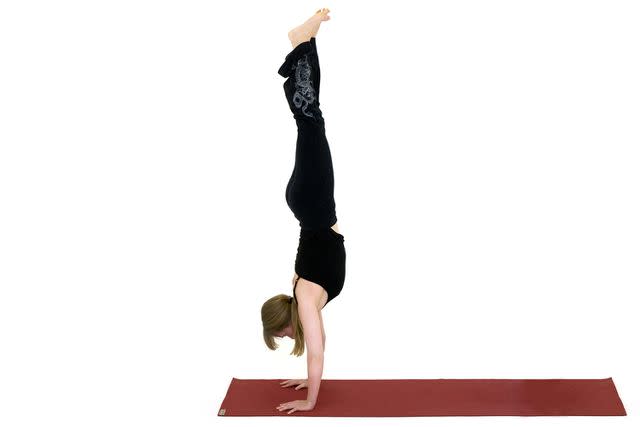
Pose type: Balance
Believe it or not, a handstand is actually a bit more difficult than a handstand and should be done with caution, ideally being performed against a wall until you feel you’ve mastered it. Similar to a headstand, it works your core and shoulders.
“With your hands under your shoulders, extend one leg up and kick the other leg up to meet it with your legs balanced above you,” says McGee. “Your arms are supporting you, but the entire body is actively engaged.” She urges the importance of pressing down in your hands evenly and using your finger pads to help you balance.
Forearm Balance
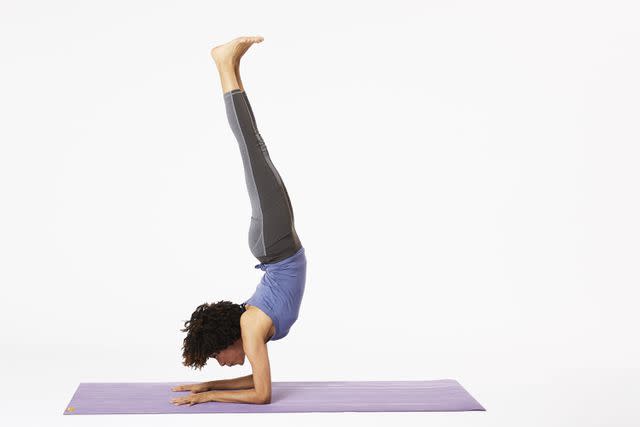
Verywell / Ben Goldstein
Pose type: Balance
This is a variation of a handstand known as Pincha Mayurasana. The forearm balance requires a great deal of core strength as well as arm and forearm strength. It’s one of McGee’s favorites for strengthening the shoulder girdle and the core.
“With your forearms on the floor and your chest and head lifted, extend one leg up and lift the other to meet it,” says McGee. “Make sure you're not sinking into your shoulders or forming a banana with the body you want to stack your legs over your hips.”
Floor Split
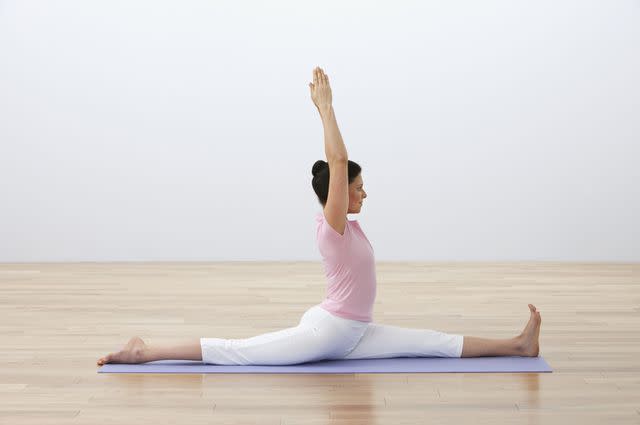
Pose type: Floor
You have likely already mastered the standing split or the downward facing dog split, however, but an intermediate or advanced yogi should be able to master the floor split. This pose may take some time until you’ve got it down pat. However, practicing every day will get you closer and closer. Over time, practicing this pose will help you open your hamstrings and hip flexors, strengthen the abs, and keep mobility in your lower body.
“From a kneeling lunge, extend your back leg behind you as you straighten your front leg out straight until the pelvis comes to the floor; keep both hips facing forward, and the back leg internally rotated,” says McGee.
King Pigeon
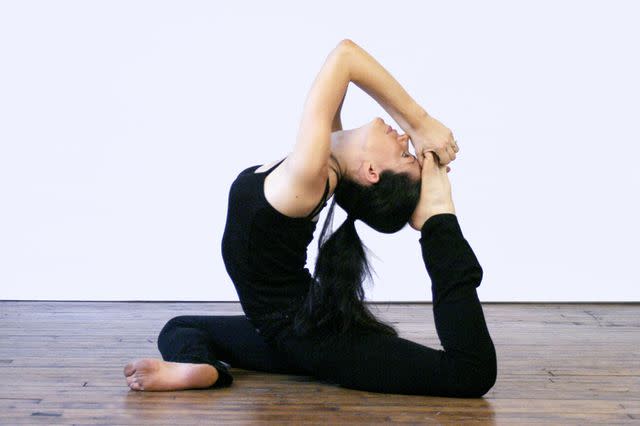
Pose type: Floor
Eka Pada Rajakapotasana, also known as pigeon pose, is one you’re probably familiar with from your beginner days. The more advanced version of this is known as King Pigeon, which helps target your hips, thighs, chest, and shoulders while providing a deep back bend.
“Bend your front leg so it's parallel with the front of the mat, extend your back leg behind you, then bend the knee and reach back to catch the foot,” says McGee. “Keep the hips square to the front of the mat and work on taking both arms overhead to catch the foot.”
Peacock
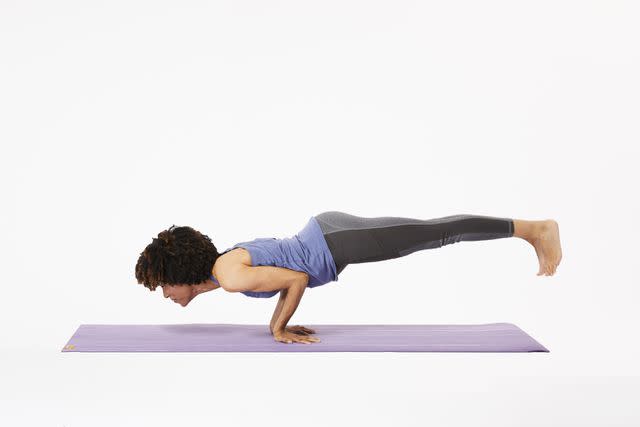
Verywell / Ben Goldstein
Pose type: Balance
This balancing floor pose, which is also called Mayurasana, is quite challenging. It targets your forearm, wrists, and upper arms while simultaneously strengthening your core and back muscles.
“Come to all fours, turn your hands backward and bring them close together, bend your elbows to create a shelf and lie your belly on top, then lift your legs up behind you,” says McGee. “This one is a huge strengthener for the posterior chain.”
Flying Pigeon Pose
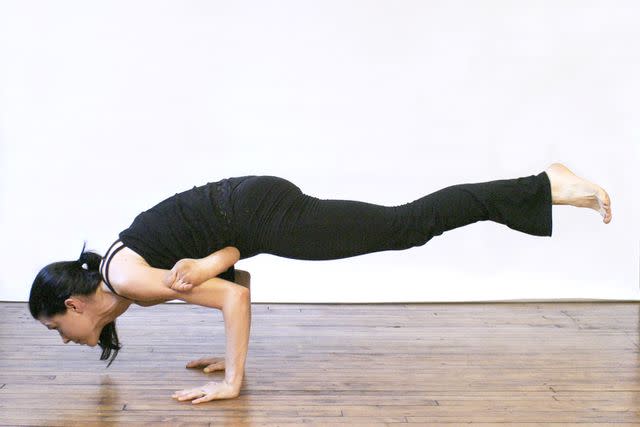
Pose type: Balance
If you can picture a pigeon pose in mid-air, that’s what the flying pigeon pose looks like. It’s an arm balance pose where one leg is placed up on the opposite arm and requires arm strength, core strength, and hip flexibility, explains Bacharach.
“Begin in a lunge position, with an outstretched leg, and place your hands on the inside of your outstretched leg,” she says. “Next, bending your elbows and bringing your outstretched knee high up onto your right upper arm, lift your back leg off the ground to engage your arms and core and hold this pose for a few seconds.”
Scorpion Pose
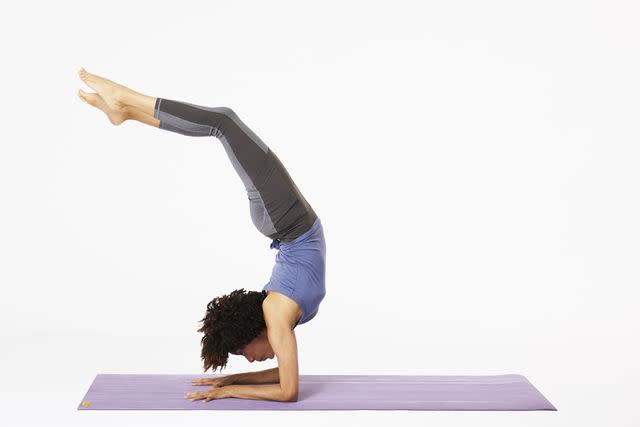
Verywell / Ben Goldstein
Pose type: Balance
With this type of inversion pose, the practitioner balances on their elbows while they lift their legs over their head. It looks even more challenging than it really is, but the benefits that can come from practicing this on a regular basis are tenfold.
“Scorpion pose helps enhance flexibility, strengthens the core, arms and helps open up the chest and can be performed by starting in a plank position,” says Bacharach. “Slowly walk your feet closer to the elbows, swing your hips into the air, and then slowly lift one leg outwards overhead by the gentle arching of the back.”
Grasshopper Pose
Pose type: Balance
With this dynamic floor pose, your body is in full-twist mode with your leg straight out to one side. “While the arms support your body, this pose twists one leg around your upper arm and requires focus, balance, and upper arm strength, and these are the areas that it helps strengthen,” says Bacharach.
Start in a crouching stance with your feet slightly wider than hip-width apart. “Lean forward, place your palms on the floor shoulder-width apart, and transfer your weight to your hands,” she says. “Swing the torso to the left, extend the left leg out to the side, hook the right ankle over the left upper arm, and maintain your hand balance.”
Dragonfly Pose
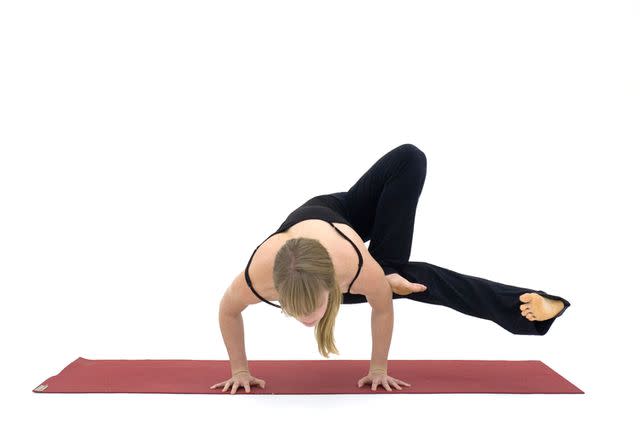
Pose type: Balance
The dragonfly pose, also known as Maksikanagasana, looks a lot like the grasshopper pose. However, there are a few important differences. With the grasshopper pose, one leg is bent and hooked around, while with the dragonfly pose, you’re bending both legs, which are extended far apart from each other.
In the dragonfly pose, the body is supported by the arms while the legs are stretched out toward the sides. “The main benefit is that it improves inner thigh flexibility, and it requires strength from the arms, shoulders, and core muscles,” says Bacharach.
To perform: Start sitting with your legs spread wide apart. Lean forward and place your palms between your legs. Raise your hips off the floor and extend your legs out to the sides while activating your inner thighs and core. After a little while of holding the pose, release it by bringing the legs back to the floor.
Visvamitrasana
Pose type: Balance
This advanced arm balance pose is named after a sage from Hindu mythology. It requires flexibility and balance but also has an element of side stretching in this pose, which helps improve hip flexibility and facilitates stretching of the hamstrings, explains Bacharach.
“Start with your legs wide apart, bend your right knee all the way, put your right hand inside your shoe, raise your left leg while straightening your right,” she says. “Before swapping sides, contract your core, open your chest, and hold the position for a short while.”
Bound Angle Pose
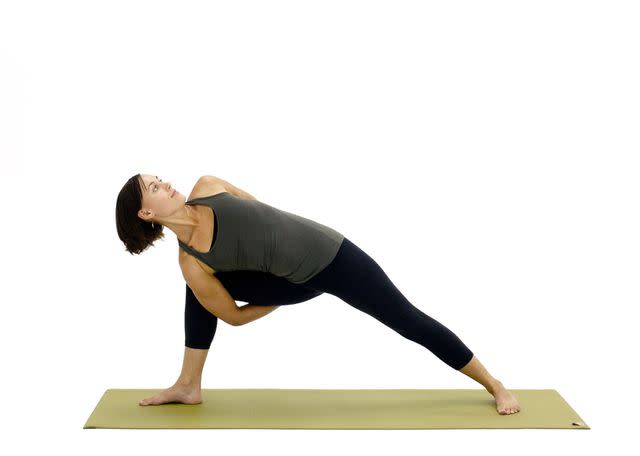
Pose type: Floor
This pose might not seem like the most challenging, but in order to perform it correctly, you have to be an intermediate or advanced yogi, according to Rachel Welch, certified health coach, yoga instructor, and founder of Revolution Motherhood. Adding a bind to your poses requires back and chest strength and mobility in order to achieve length without pulling on your shoulder capsules or rotator cuffs, she explains.
“Begin with 1/2 binds, meaning just the top arm (either twisted or open), and allow your torso and shoulder blades to begin to glide into the bind instead of the natural reaction to a bind, which is to collapse the chest and pull from the front of the shoulder girdle,” she says. “A bind requires strong core engagement for your balance since your arms can no longer catch you or stabilize, but binding is exceptional for gut health, giving your kidneys and adrenal glands a reset and learning to connect deeply to your internal balance.”
Sage Pose II
Pose type: Floor
This complex arm balance calls for balance, hip flexibility, and arm, and core strength. “The aim of this pose is to have one leg hooked over the upper arm,” says Bacharach. “This position improves hip flexibility and balance while strengthening the core, shoulders, and arms muscles.”
Begin in a low lunge, place your hands on the floor inside your right foot, shift your weight forward, bend your elbows, and raise your right knee up onto your right upper arm. Then contract your core and raise your back leg off the floor.
Boat Pose
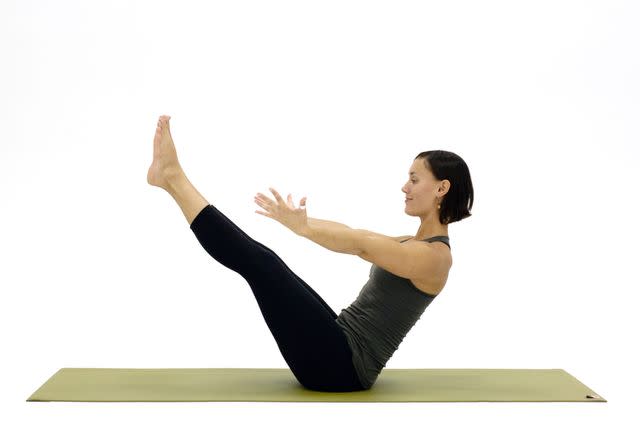
Pose type: Balancing
If you're looking to work your core muscles through yoga, this is a great pose to focus on. It requires you to balance on your tailbone with your legs lifted up. From the side angle, you sort of look like a boat, hence its name. Its Sanskrit name is Paripurna Navasana.
Start out in a seated position with your knees bent and your feet flat on the floor. Leaning back slightly, start to engage your core muscles while simultaneously lifting your feet from the mat. Extend your arms forward so that they are parallel to the ground. Try to make it so that your palms are facing each other. Find your balance on your sit bones and create a V-shape with your body. Straighten your legs so that they are at a 45-degree angle from the floor.
Avoid rounding your back and hold this pose for several breaths, engaging your core so that you maintain balance.
Seated Forward Bend
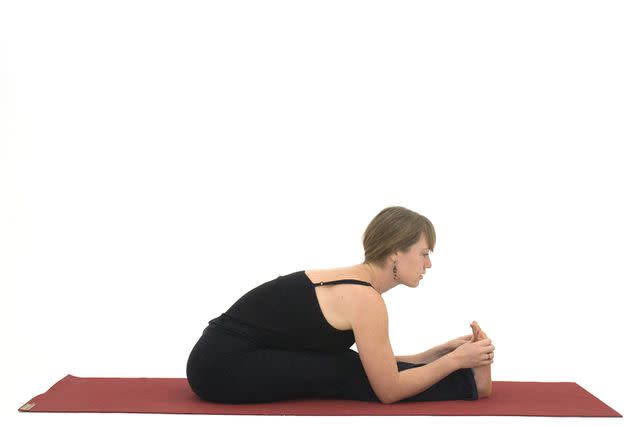
Pose type: Floor
This pose is better known as Paschimottanasana in the yogi world. It involves deep stretching in a forward fold. With this kind of deep stretch, you reach beyond the superficial length of your external muscles and begin to soften and lengthen the fascial layers down to your skeletal structure, explains Welch. “It requires patience and an ability to remain on the edge of discomfort without fighting, but instead surrendering.”
Start in a seated position with your legs extended out in front of you and your feet flexed towards the ceiling. With a deep inhale, reach your arms overhead and bend entirely forward, reaching toward your feet. Maintain a straight spin and focus on your breathing—relaxing with each exhale.
Wild Thing Pose
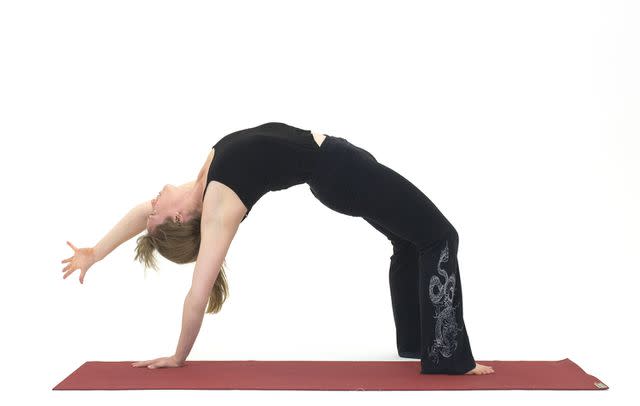
Pose type: Backbend
Also known as Camatkarasana, this pose requires balance, flexibility in the spine, and strength in the shoulders, legs, and core, according to Bacharach. The Wild Thing pose aims to promote general spinal flexibility and balance.
Start in a high plank posture. Then, raise your hips, shift your weight onto your right hand, and place it on the outside edge of your right foot. Next, stretch your left leg behind you, raise your hips higher, and reach your left arm overhead. Finally, arch your spine before lowering yourself back into the plank position.
Eagle Pose
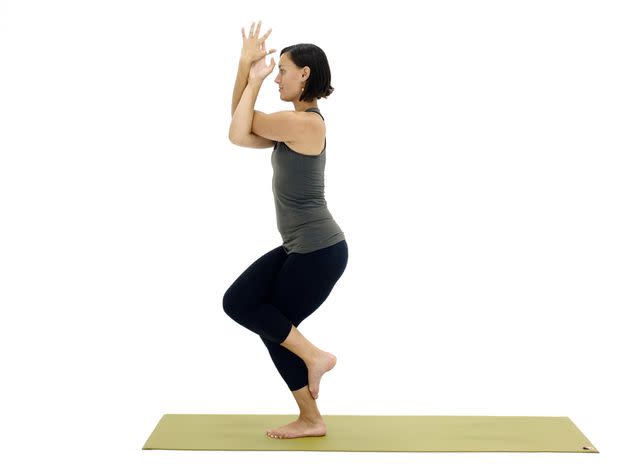
Pose type: Balancing
Also known as Garudasana, the Eagle pose requires a strong focus to allow you to balance on one leg while simultaneously wrapping the opposite leg around it. Your arms are intertwined and wrapped around each other in a similar way so that your body is completely aligned in a vertical fashion.
Start out in a standing position, also known as Mountain Pose (or Tadasana). Shifting your weight onto one of your feet, lift the other high up with your knee coming up towards your chest. Cross your right thigh over your left and hook your right foot behind the opposite calf. Stack your knees on top of each other and bring your arms to shoulder height. Cross one arm over the right and bring your palms together. Engage your core to help you balance.
Half Moon Pose
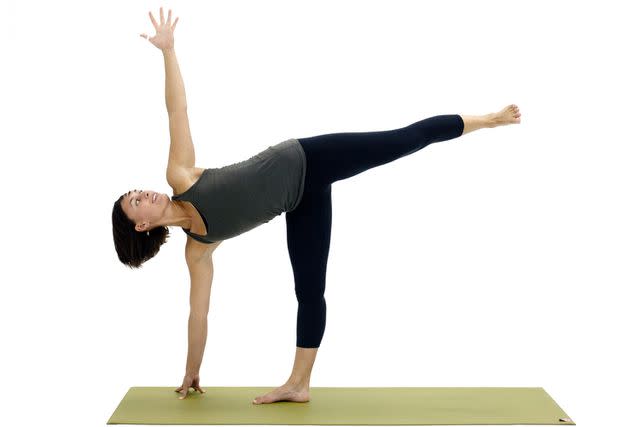
Pose type: Balancing
This challenging pose is a great test of your ability to balance. It requires you to extend your extremities outwards while tightening your core enough to maintain the position for several seconds. In Sanskrit, it is called Ardha Chandrasana, and it involves balancing on one leg while extending the opposite leg parallel to the ground.
From a standing position, slowly shift your weight onto one foot while lifting the other off the mat. Place one hand on the floor or on a block while simultaneously extending your other leg straight back so that it is completely parallel to the ground. Open up your hips and shoulders, stacking that hip over the other with one shoulder.
Make sure that your arm is reaching towards the ceiling and focus your gaze towards the floor. Hold the pose and breathe throughout.
Read the original article on Verywell Fitness.

